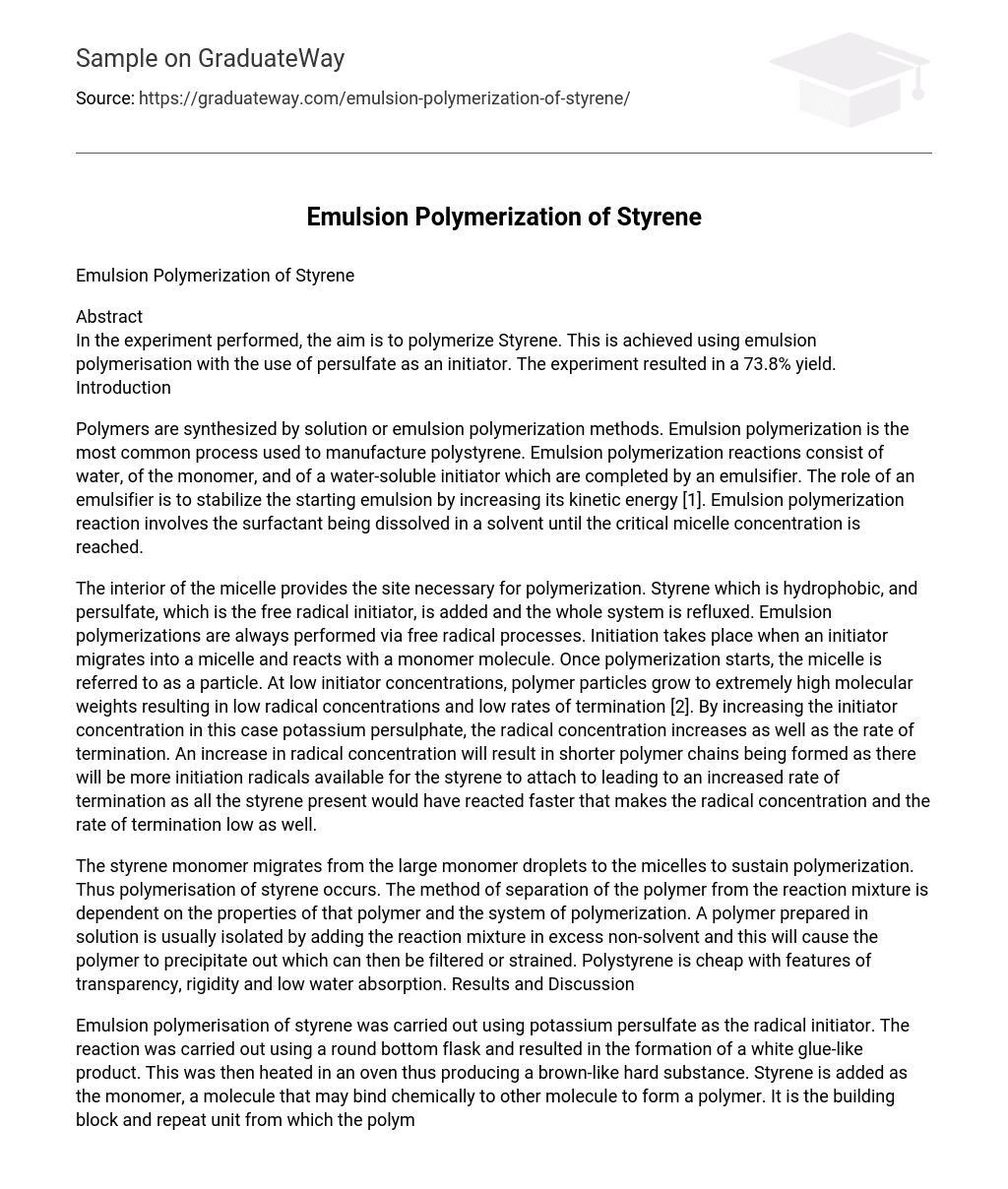Abstract
In the experiment performed, the aim is to polymerize Styrene. This is achieved using emulsion polymerisation with the use of persulfate as an initiator. The experiment resulted in a 73.8% yield. Introduction
Polymers are synthesized by solution or emulsion polymerization methods. Emulsion polymerization is the most common process used to manufacture polystyrene. Emulsion polymerization reactions consist of water, of the monomer, and of a water-soluble initiator which are completed by an emulsifier. The role of an emulsifier is to stabilize the starting emulsion by increasing its kinetic energy [1]. Emulsion polymerization reaction involves the surfactant being dissolved in a solvent until the critical micelle concentration is reached.
The interior of the micelle provides the site necessary for polymerization. Styrene which is hydrophobic, and persulfate, which is the free radical initiator, is added and the whole system is refluxed. Emulsion polymerizations are always performed via free radical processes. Initiation takes place when an initiator migrates into a micelle and reacts with a monomer molecule. Once polymerization starts, the micelle is referred to as a particle. At low initiator concentrations, polymer particles grow to extremely high molecular weights resulting in low radical concentrations and low rates of termination [2]. By increasing the initiator concentration in this case potassium persulphate, the radical concentration increases as well as the rate of termination. An increase in radical concentration will result in shorter polymer chains being formed as there will be more initiation radicals available for the styrene to attach to leading to an increased rate of termination as all the styrene present would have reacted faster that makes the radical concentration and the rate of termination low as well.
The styrene monomer migrates from the large monomer droplets to the micelles to sustain polymerization. Thus polymerisation of styrene occurs. The method of separation of the polymer from the reaction mixture is dependent on the properties of that polymer and the system of polymerization. A polymer prepared in solution is usually isolated by adding the reaction mixture in excess non-solvent and this will cause the polymer to precipitate out which can then be filtered or strained. Polystyrene is cheap with features of transparency, rigidity and low water absorption. Results and Discussion
Emulsion polymerisation of styrene was carried out using potassium persulfate as the radical initiator. The reaction was carried out using a round bottom flask and resulted in the formation of a white glue-like product. This was then heated in an oven thus producing a brown-like hard substance. Styrene is added as the monomer, a molecule that may bind chemically to other molecule to form a polymer. It is the building block and repeat unit from which the polymer is grown. Sodium dihydrogen phosphate was added to the flask as a buffering agent. This is to maintain a controlled pH throughout the polymerization reaction. a buffering agent is normally employed when potassium persulfate is used as the radical initiator.
Sodium dodecyl sulphate is added to act as a surfactant, a molecule with both hydrophobic and hydrophilic portions, to stabilize and disperse hydrophobic molecules and aggregates of hydrophobic molecules in the reaction mixture. Potassium persulfate is used as a radical initiator. The radical initiator is capable of providing a source of free radicals, either induced spontaneously, or by exposure to heat or light. The radical initiator is added to the reaction mixture in an amount sufficient to initiate and maintain the polymerization reaction at a desired reaction rate. The persulfate readily breaks up to form a sulfate radical. The initiators used need to be water soluble and partition into the water phase. Such initiators are persulfates and peroxides. In Lab Questions:
1.The aluminium potassium sulphate provides SO4- ions which serve to terminate the reaction and allow for completion of the reaction to occur and to completely precipitate out the polymer from the micelles.
2.Styrene:
Mass of empty vial: 11.2355g
Mass of vial + sample: 12.9130g
Mass of polystyrene : 1.6775g
m = ?.V
= (909kg.m-3) x (2.5×10-6m3)
= 2.2725×10-3kg
= 2.2725g
Percentage yield = (actual yield / theoretical yield) x 100
= (1.6775 / 2.2725) x100
= 73.8%
3.Polymers do not have a well-defined molecular mass. They contain chains of varying lengths; therefore the molecular weights vary as each chain consists of various numbers of atoms. In the emulsion polymerization of styrene, decreasing the initiator concentration results in increased molecular weight and rate of polymerization. Therefore the molecular mass can be controlled by controlling the initiator concentration.
Conclusion
The practical conducted resulted in the formation of a white glue-like compound which later turned brown upon heating. The percentage yield obtained for the polystyrene was 73.8%. References
[1] D. Cochin, A. Laschewsky, F. Nallet, Emulsion Polymerization of Styrene Using Conventional, Polymerizable, and Polymeric Surfactants. A Comparative Study, Macromolecules 1997, 30, 2278-2287 [2] appchemdaily.blogspot.com/2012/07/emulsion





